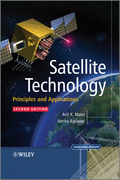
A comprehensive, single-source reference on satellite technology and its applications, Satellite Technology: Principles and Applications, Second Editionincludes the latest developments on the topic. Covering the features and facilities of satellites and satellite launch vehicles, with an emphasis on the fundamental principles and concepts, the authors provide readers with a complete understanding of the technology. This book explains the past, present and future satellite missions, as well as non-communication related applications. Coverage ranges from remote sensing and navigational uses to meteorological and military areas. This second edition contains an additional chapter on earth stationdesign and gives extensive focus to space based weapon systems, satellite interference and future trends in satellite technology. Extra information has also been provided on all of the first edition's topics to enhance the existing coverage. * Fully updated new edition with latest technological developments * Covers the full range of important applications such remote sensing, weather forecasting, navigational, scientific and military applications * Amply illustrated with figures and photographs, this book also contains problems with solutions, which is of benefit students at undergraduate and graduate levels * An indispensible book for professionals and students in the field of satellite technology * Companion website provides a complete and updated compendium on satellites and satellite launch vehicles INDICE: Table of Contents PART I SATELLITE TECHNOLOGY 1 1 Introduction to Satellites and Their Applications 1.1 Ever-expanding Application Spectrum 1.2 What is a Satellite? 1.3 History of the Evolution of Satellites 1.4 Evolution of Launch Vehicles 1.5 Future Trends Further Reading Glossary 2 Satellite Orbits and Trajectories 2.1 Definition of an Orbit and a Trajectory 2.2 Orbiting Satellites Basic Principles 2.3 Orbital Parameters 2.4 Injection Velocity and Resulting Satellite Trajectories 2.5 Types of Satellite Orbits Further Reading Glossary 3 Satellite Launch and In-Orbit Operations 3.1 Acquiring the Desired Orbit 3.2 Launch Sequence 3.3 Orbital Perturbations 3.4 Satellite Stabilization 3.5 Orbital Effects on Satellites Performance 3.6 Eclipses 3.7 Look Angles of a Satellite 3.8 Earth Coverage and Ground Tracks Further Reading Glossary 4 Satellite Hardware 4.1 Satellite Subsystems 4.2 Mechanical Structure 4.3 Propulsion Subsystem 4.4 Thermal Control Subsystem 4.5 Power Supply Subsystem 4.6 Attitude and Orbit Control 4.6.1 Attitude Control 4.6.2 Orbit Control 4.7 Tracking, Telemetry and Command Subsystem 4.8 Payload 4.9 Antenna Subsystem 4.10 Space Qualification and Equipment Reliability Further Reading Glossary 5 Communication Techniques 5.1 Types of Information Signals 5.2 Amplitude Modulation 5.3 Frequency Modulation 5.4 Pulse Communication Systems 5.5 Sampling Theorem 5.6 ShannonHartley Theorem 5.7 Digital Modulation Techniques 5.8 Multiplexing Techniques Further Reading Glossary 6 Multiple Access Techniques 6.1 Introduction to Multiple Access Techniques 6.2 Frequency Division Multiple Access (FDMA) 6.3 Single Channel per Carrier (SCPC) Systems 6.4 Multiple Channels Per Carrier (MCPC) Systems 6.5 Time Division Multiple Access (TDMA) 6.6 TDMA Frame Structure 6.7 TDMA Burst Structure 6.8 Computing Unique Word Detection Probability 6.9 TDMA Frame Efficiency 6.10 Control and Coordination of Traffic 6.11 Frame Acquisition and Synchronization 6.12 FDMA vs. TDMA 6.13 Code Division MultipleAccess (CDMA) 6.14 Space Division Multiple Access (SDMA) Further Reading Glossary 7 Satellite Link Design Fundamentals 7.1 Transmission Equation 7.2 Satellite Link Parameters 7.3 Frequency Considerations 7.4 Propagation Considerations 7.5 Techniques to Counter Propagation Effects 7.6 Noise Considerations 7.7 Interference-related Problems 7.8 Antenna Gain-to-noise Temperature (G/T) Ratio7.9 Link Design Further Reading Glossary 8 Earth Station Earth Station Types of Earth Stations Earth Station Architecture Earth Station Design Considerations Earth Station Testing Earth Station Hardware Satellite Tracking Some Representative Earth Stations Further Reading Glossary PART II SATELLITE APPLICATIONS 9 Communication Satellites 9.1 Introduction to Communication Satellites 9.2 Communication-Related Applications of Satellites 9.3 Frequency Bands 9.4 Payloads 9.5 Satellite versus Terrestrial Networks 9.6 Satellite Telephony 9.7 Satellite Television 9.8 Satellite Radio 9.9 Satellite Data Communication Services9.10 Important Missions 9.11 Future Trends Further Reading Glossary 10 RemoteSensing Satellites 10.1 Remote Sensing An Overview 10.2 Classification of Satellite Remote Sensing Systems 10.3 Remote Sensing Satellite Orbits 10.4 RemoteSensing Satellite Payloads 10.5 Passive Sensors 10.6 Active Sensors 10.7 Types of Images 10.8 Image Classification 10.9 Image Interpretation 10.10 Applications of Remote Sensing Satellites 10.11 Major Remote Sensing Missions 10.12 Future Trends Further Reading Glossary 11 Weather Satellites 11.1 Weather Forecasting An Overview 11.2 Weather Forecasting Satellite Fundamentals 11.3 Images from Weather Forecasting Satellites 11.4 Weather Forecasting Satellite Orbits 11.5 Weather Forecasting Satellite Payloads 11.6 Image Processing and Analysis11.7 Weather Forecasting Satellite Applications 11.8 Major Weather Forecasting Satellite Missions 11.9 Future of Weather Forecasting Satellite Systems Further Reading Glossary 12 Navigation Satellites 12.1 Development of Satellite Navigation Systems 12.2 Global Positioning System (GPS) 12.3 Working Principle of the GPS 12.4 GPS Positioning Services and Positioning Modes 12.5 GPS Error Sources 12.6 GLONASS Satellite System 12.7 GPS-GLONASS Integration 12.8 Applications of Satellite Navigation Systems 12.9 Future of Satellite Navigation Systems Further Reading Glossary 13 Scientific Satellites 13.1 Satellite-Based versus Ground-Based Scientific Techniques 13.2 Payloads on Board Scientific Satellites 13.3 Applications of Scientific Satellites Study of Earth 13.4 Observation of the Earths Environment 13.5 Astronomical Observations 13.6 Missions for Studying Planets of the Solar System 13.7 Missions Beyond the Solar System 13.8 Other Fields of Investigation 13.9 Future Trends Further Reading Glossary 14Military Satellites 14.1 Military Satellites An Overview 14.2 Satellite Military Communication 14.3 Development of Military Communication Satellite Systems14.4 Frequency Spectrum Utilized by Military Communication Satellite Systems 14.5 Dual-use Military Satellite Communication Satellite Systems 14.6 Reconnaissance Satellites 14.7 SIGINT Satellites 14.8 Early Warning Satellites 14.9 Nuclear Explosion Satellites 14.10 Military Weather Forecasting Satellites 14.11Military Navigation Satellites 14.12 Space Weapons 14.13 Strategic Defence Initiative 14.14 Directed Energy Laser Weapons 14.15 Advanced Concepts Further Reading Glossary Subject Index
- ISBN: 978-0-470-66024-9
- Editorial: John Wiley & Sons
- Encuadernacion: Cartoné
- Páginas: 696
- Fecha Publicación: 15/10/2010
- Nº Volúmenes: 1
- Idioma: Inglés
